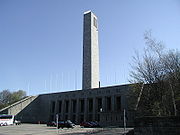
Bell tower Olympic Stadium Berlin
Encyclopedia

Olympic Stadium (Berlin)
The Olympiastadion is a sports stadium in Berlin, Germany. There have been two stadiums on the site: the present facility, and one that is called the Deutsches Stadion which was built for the aborted 1916 Summer Olympics. Both were designed by members of the same family, the first by Otto March...
was a 77 metres high observation tower that was built in 1934 after plans by professor
Professor
A professor is a scholarly teacher; the precise meaning of the term varies by country. Literally, professor derives from Latin as a "person who professes" being usually an expert in arts or sciences; a teacher of high rank...
Werner March
Werner March
Werner Julius March was a German architect.He was born in Charlottenburg and died in Berlin.For the 1936 Summer Olympics in Germany, March created his most famous work, Berlin's Olympic Stadium...
. The steel skeleton construction was covered with limestone plates.
After the Second World War
World War II
World War II, or the Second World War , was a global conflict lasting from 1939 to 1945, involving most of the world's nations—including all of the great powers—eventually forming two opposing military alliances: the Allies and the Axis...
the Soviet troops
Red Army
The Workers' and Peasants' Red Army started out as the Soviet Union's revolutionary communist combat groups during the Russian Civil War of 1918-1922. It grew into the national army of the Soviet Union. By the 1930s the Red Army was among the largest armies in history.The "Red Army" name refers to...
accidentally set the tower's contents on fire and it was no longer stable. Therefore the British
United Kingdom
The United Kingdom of Great Britain and Northern IrelandIn the United Kingdom and Dependencies, other languages have been officially recognised as legitimate autochthonous languages under the European Charter for Regional or Minority Languages...
engineers blown it up in 1947. The Olympic Bell - weighting 9,6 ton
Ton
The ton is a unit of measure. It has a long history and has acquired a number of meanings and uses over the years. It is used principally as a unit of weight, and as a unit of volume. It can also be used as a measure of energy, for truck classification, or as a colloquial term.It is derived from...
s, survived the fire and remained in its place in the tower - fell 77 metres, cracked and has been unable to sound since then. In 1956 the bell was rescued, only in order to be used as a practice target for shooting with anti-tank
Anti-tank warfare
Anti-tank warfare was created by the need to seek technology and tactics to destroy tanks and their supporting infantry during the First World War...
ammunition. The old bell survives to this day and serves now as a memorial.
Between 1960 and 1962 the tower was rebuilt following the old plans, although the tower is now 77,17 metres high. In it hangs the present Olympic Bell weighting 4,5 tons with the German Federal Eagle
Coat of arms of Germany
The coat of arms of Germany displays a black eagle on a yellow shield ....
, the Brandenburg Gate
Brandenburg Gate
The Brandenburg Gate is a former city gate and one of the most well-known landmarks of Berlin and Germany. It is located west of the city centre at the junction of Unter den Linden and Ebertstraße, immediately west of the Pariser Platz. It is the only remaining gate of a series through which...
and the texts between the Olympic Rings: Olympic Games 1936 and I call the youth of the world. The bell rings the note F sharp.
The tower is an important tourist destination offering a panorama of Berlin
Berlin
Berlin is the capital city of Germany and is one of the 16 states of Germany. With a population of 3.45 million people, Berlin is Germany's largest city. It is the second most populous city proper and the seventh most populous urban area in the European Union...
, Spandau
Spandau
Spandau is the fifth of the twelve boroughs of Berlin. It is the fourth largest and westernmost borough, situated at the confluence of the Havel and Spree rivers and along the western bank of the Havel, but the least populated.-Overview:...
, the Havel
Havel
The Havel is a river in north-eastern Germany, flowing through the German states of Mecklenburg-Vorpommern, Brandenburg, Berlin and Saxony-Anhalt. It is a right tributary of the Elbe river and in length...
Valley, Potsdam
Potsdam
Potsdam is the capital city of the German federal state of Brandenburg and part of the Berlin/Brandenburg Metropolitan Region. It is situated on the River Havel, southwest of Berlin city centre....
, Nauen
Nauen
Nauen is a town in the Havelland district, in Brandenburg, Germany. It is situated 38 km west of Berlin and 26 km northwest of Potsdam.-History:...
and Hennigsdorf
Hennigsdorf
Hennigsdorf is a town in the district of Oberhavel, in Brandenburg, Germany. It is situated north-west of Berlin, just across the city border, which is formed mainly by the Havel river.-History:...
.

